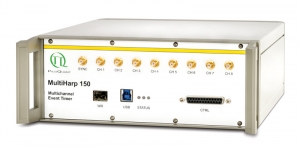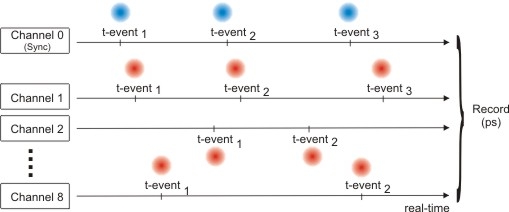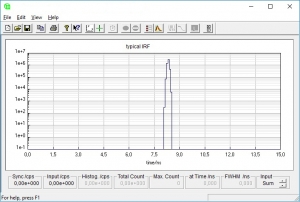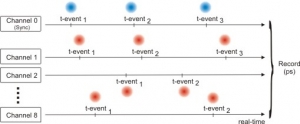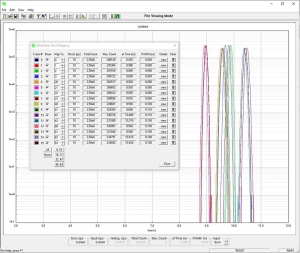TCSPC and Time Tagging Electronics
MultiHarp 150
High-Throughput Multichannel Event Timer & TCSPC Unit
- Ships within 2 weeks
- 4, 8, or 16 independent input channels
- Common sync channel (up to 1.2 GHz sync rate)
- Highest sustained data throughput (85 Mcps in time tagging mode, up to 180 Mcps in histogramming mode)
- Ultrashort dead time (650 ps), no dead time across channels
- Ref In/Ref Out/PPS In/White Rabbit interface for multi-device synchronization
- Drivers and Python wrapper snAPI for seamless communication, configuration, data handling and custom programming
- Multifunctional on-board event filters for “P” versions
- NEW: Hardware access to data stream via external FPGA interface for “P” versions
Contact us to get a quote for further questions. It is also possible to get a personal free demo unit to test your application.
- Description
- Specifications
- Software
- TTTR modes
- Applications
- Images
- Documents
- Publications
Contact us
 The MultiHarp 150 is an easy-to-use, plug-and-play multichannel event timer and Time-Correlated Single Photon Counting (TCSPC) device. Its extremely fast signal processing leads to an excellent data throughput via USB 3.0 interface. The MultiHarp 150 is a compact, robust, and reliable device whose high quality is reflected by our unique 5-year limited warranty. A recently published paper by M. Wahl et al. (pre-print on ArXiv) showcases design features as well as benchmark and application results from spectrally resolved, high speed imaging applications.
The MultiHarp 150 is an easy-to-use, plug-and-play multichannel event timer and Time-Correlated Single Photon Counting (TCSPC) device. Its extremely fast signal processing leads to an excellent data throughput via USB 3.0 interface. The MultiHarp 150 is a compact, robust, and reliable device whose high quality is reflected by our unique 5-year limited warranty. A recently published paper by M. Wahl et al. (pre-print on ArXiv) showcases design features as well as benchmark and application results from spectrally resolved, high speed imaging applications.
Multiple input channels, outstanding flexibility
The MultiHarp 150 is available with either 4, 8, or 16 identical detection channels, which are synchronized but independent, and either 5 ps (P) or 80 ps (N) base resolution. Each model features also one common synchronization input. All channels including the sync input can be used as detector inputs, e.g., for coincidence correlation or coincidence counting. The MultiHarp 150 is also ideally suited for performing TCSPC with multiple detectors using forward start-stop operation. Here the common sync channel allows for synchronization with the excitation source.
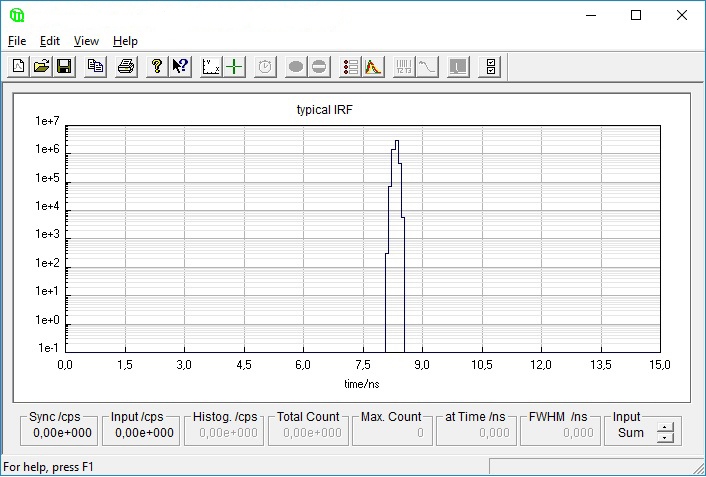 Ultrashort dead time for high data throughput
Ultrashort dead time for high data throughput
The smartly designed timing electronics allows to fully exploit the count rate limits of time-correlated single photon counting, without having to compromise on the time resolution for many modern single photon detectors. The ultra short dead time of 650 ps allows detecting multiple photons per excitation cycle even at the highest repetition rates achievable by modern picosecond pulsed lasers (requires a detector from the PMA Hybrid Series).
Adjustable timing offsets for each input channel
Each input channel has internal adjustable timing offsets with ±100 ns range at 5 ps (P) or 80 ps (N) steps steps. This greatly simplifies the cabling requirements for experimental set-ups, as selecting cable lengths to compensate for signal delays is no longer needed.
Operation as time tagger
The Time-Tagged Time-Resolved (TTTR) modes supported by the MultiHarp 150 record all relevant time and channel routing information of each detected individual photon event. By storing this full data set, it becomes possible to carry out the most comprehensive and sophisticated analysis of photon dynamics after a measurement. A real time data correlator is included to monitor FCS experiments at count rates of up to 1 000 000 counts/sec. Furthermore, the MultiHarp 150 can be synchronized with other hardware such as scanners when operated in TTTR mode.
Multifunctional on-board event filters
The MultiHarp 150 4P, 8P, and 16P have user-defineable on-board event filters to efficiently reduce the file sizes and the amount of data sent via the USB interface.
 World's first White Rabbit ready event timer
World's first White Rabbit ready event timer
White Rabbit is a fully deterministic, Ethernet-based timing network which provides sub-nanosecond accuracy and precise synchronization of devices over large distances. Thanks to its White Rabbit interface, the MultiHarp 150 is prepared to be used in networks that are based on this emerging technology.
Download our free White Paper to learn more about the flawless interoperability of the MultiHarp devices with the switches from Seven Solutions.
Easy-to-use software included, custom programming supported
The MultiHarp 150 comes with a Windows software package that providing all important functions such as setting measurement parameters, displaying results, loading/saving of measurement parameters and measurement curves. Important measurement data, including count rate, count maximum, position and peak width are continuously displayed. A comprehensive online help system eases the user into fully employing the capabilities of the MultiHarp 150. A library for custom programming, e.g., with LabVIEW is also included. PicoQuant is committed to the support and development of this software and upgrades with extended functionality will be made available.
The MultiHarp 150 can be used in different operation modes:
- Integration mode
- Oscilloscope mode
- Time-Tagged Time-Resolved mode (listing each event arrival time)
- On-line ("real-time") correlator for FCS
| MultiHarp 150 P | MultiHarp 150 N | |
|---|---|---|
| Input channels and sync | constant level trigger on all inputs, software adjustable | constant level trigger on all inputs, software adjustable |
| Number of detector channels (in addition to sync) | 4 (MultiHarp 150 4P), 8 (MultiHarp 150 8P), or 16 (MultiHarp 150 16P) | 4 (MultiHarp 150 4N) or 8 (MultiHarp 150 8N) |
| Input voltage operating range (pulse peak into 50 Ohms) | -1200 mV to 1200 mV | -1200 mV to 1200 mV |
| Input voltage max. range (damage level) | ±2500 mV | ±2500 mV |
| Trigger edge | falling or rising edge, software adjustable | falling or rising edge, software adjustable |
| Trigger pulse width | > 0.4 ns | > 0.4 ns |
| Trigger pulse required rise/fall time | ≤ 20 ns | ≤ 20 ns |
| Time to Digital Converters | ||
| Minimum time bin width | 5 ps | 80 ps |
| Timing precision* | < 28 ps rms | < 85 ps rms |
| Timing precision / √2* | < 20 ps rms | < 60 ps rms |
| Dead time | < 650 ps (can be increased via software up to 160 ns in steps of 1 ns) | < 650 ps (can be increased via software up to 160 ns in steps of 1 ns) |
| Maximum sync rate (periodic pulse train) | 1.2 GHz | 1.2 GHz |
| Adjustable programmable time offset for each input channel | ±100 ns, resolution 5 ps | ±100 ns, resolution 80 ps |
| Differential non-linearity | < 5 % peak to peak, < 1 % rms (over full measurement range) | < 10 % peak to peak, < 1 % rms (over full measurement range) |
| Histogrammer | ||
| Count depth | 32 bit (4 294 967 295 counts) | 32 bit (4 294 967 295 counts) |
| Maximum number of time bins | 65 536 | 65 536 |
| Full scale time range | 327 ns to 2.74 s (depending on chosen resolution: 5, 10, 20, …, 41 943 040 ps) | 5.24 µs to 21.99 s (depending on chosen resolution: 80, 160, 320, …, 335 544 320 ps) |
| Acquisition time | 1 ms to 100 hours | 1 ms to 100 hours |
| Peak count rate per input channel | 1.5 × 109 counts/sec for burst durations up to 1.3 µs | 1.5 × 109 counts/sec for burst durations up to 1.3 µs |
| Total sustained count rate, sum over all input channels | 166 × 106 counts/sec (4P and 8P) 332 × 106 counts/sec (16P) |
180 × 106 counts/sec |
| TTTR Engine | ||
| T2 mode resolution | 5 ps | 80 ps |
| T3 mode resolution | 5, 10, 20, …, 41 943 040 ps | 80, 160, 320, …, 335 544 320 ps |
| FiFo buffer depth (records) | 134 217 728 events | 134 217 728 events |
| Acquisition time | 1 ms to 100 hours | 1 ms to 100 hours |
| Peak count rate per input channel | 1.5 × 109 counts/sec for burst durations up to 1.3 µs | 1.5 × 109 counts/sec for burst durations up to 1.3 µs |
| Sustained count rate per input channel** | 78 × 106 counts/sec | 78 × 106 counts/sec |
| Total sustained count rate, sum over all input channels** | 85 × 106 counts/sec | 85 × 106 counts/sec |
| FPGA Data Interface | ||
| Throughput T2/T3 Mode | 156 × 106 counts/sec | not included in “N” version |
| Latency T2 Mode | 4.5 µs to 5.0 µs | |
| Latency T3 Mode | 4.5 µs to 5.0 µs | |
| Trigger Output | ||
| Period | programmable, 0.1 µs to 1678 s (0.596 Hz to 10 MHz) | programmable, 0.1 µs to 1678 s (0.596 Hz to 10 MHz) |
| Pulse width | 10 ns typ. | 10 ns typ. |
| Baseline level | 0 V typ. | 0 V typ. |
| Active level (pulse peak) | -0.7 V typ. (50 Ohm) | -0.7 V typ. (50 Ohm) |
| External Synchronization | ||
| Ref. IN | 10 MHz 200 … 1500 mV p.p. 50 Ohm, AC coupled |
10 MHz 200 … 1500 mV p.p. 50 Ohm, AC coupled |
| Ref. OUT | default: 10 MHz White Rabbit mode: 31.25 MHz 1400 MHz 50 Ohm, AC coupled |
default: 10 MHz White Rabbit mode: 31.25 MHz 1400 MHz 50 Ohm, AC coupled |
| PPS IN | 1 s, LVTTL | 1 s, LVTTL |
| White Rabbit interface | connector for SFP module | connector for SFP module |
| External Marker Inputs | ||
| Number | 4 | 4 |
| Input type | LVTTL, < 50 ns rise/fall time, > 50 ns at HIGH or LOW (max 5V for 1 µs) | LVTTL, < 50 ns rise/fall time, > 50 ns at HIGH or LOW (max 5V for 1 µs) |
| Operation | ||
| PC interface | USB 3.0 | USB 3.0 |
| PC requirements | Dual Core CPU or better, min. 2 GHz CPU clock, min. 4 GB memory | Dual Core CPU or better, min. 2 GHz CPU clock, min. 4 GB memory |
| Operating system | Windows 10/11 | Windows 10/11 |
| Power consumption | < 50 W | < 50 W |
| Operation environment | Indoor use only | Indoor use only |
| Operation altitude | Max. 2000 m above sea level | Max. 2000 m above sea level |
| Dimensions | ||
| versions with 4 or 8 detector channels | incl. feet and handles 305 × 240 × 95 mm | incl. feet and handles 305 × 240 × 95 mm |
| versions with 16 detector channels | incl. feet and handles 305 × 350 × 95 mm | incl. feet and handles 305 × 350 × 95 mm |
* In order to determine the timing precision it is necessary to repeatedly measure a time difference and to calculate the standard deviation (rms error) of these measurements. This is done by splitting an electrical signal from a pulse generator and feeding the two signals each to a separate input channel. The differences of the measured pulse arrival times are calculated along with the corresponding standard deviation. This latter value is the rms jitter which we use to specify the timing precision. However, calculating such a time difference requires two time measurements. Therefore, following from error propagation laws, the single channel rms error is obtained by dividing the previously calculated standard deviation by √(2). We also specify this single channel rms error here for comparison with other products.
** Sustained throughput depends on configuration and performance of host PC.
All Information given here is reliable to our best knowledge. However, no responsibility is assumed for possible inaccuracies or omissions. Specifications and external appearances are subject to change without notice.
Compatible with UniHarp – Your Free TCSPC Data Acquisition Software
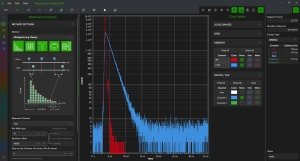 UniHarp is PicoQuant’s intuitive and powerful DAQ software for our TCSPC and time-tagging devices. It streamlines your workflow with real-time control, sleek visualization, and flexible data saving. From time traces and histograms to advanced correlation measurements (including FCS and g²), UniHarp gives you an easy start into your experiments. With intuitive parameter-setting tools, it puts full control at your fingertips.
UniHarp is PicoQuant’s intuitive and powerful DAQ software for our TCSPC and time-tagging devices. It streamlines your workflow with real-time control, sleek visualization, and flexible data saving. From time traces and histograms to advanced correlation measurements (including FCS and g²), UniHarp gives you an easy start into your experiments. With intuitive parameter-setting tools, it puts full control at your fingertips.
Easy-to-use software included and custom programming supported
The MultiHarp 150 comes with a Windows software package that providing all important functions such as setting measurement parameters, displaying results, loading/saving of measurement parameters and measurement curves. Important measurement data, including count rate, count maximum, position and peak width are continuously displayed. A comprehensive online help system eases the user into fully employing the capabilities of the MultiHarp 150. A library for custom programming, e.g., with LabVIEW is also included. PicoQuant is committed to the support and development of this software and upgrades with extended functionality will be made available.
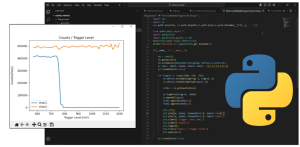 Fast, intuitive, and versatile Python wrapper snAPI
Fast, intuitive, and versatile Python wrapper snAPI
snAPI serves as a bridge between the capabilities of PicoQuant's TCSPC devices and the Python ecosystem, offering efficient device communication, configuration, and data handling for all users.
Operation and software features
The MultiHarp 150 can be used in various operation modes:
Integration mode
Measurement of the accumulated events as a function of time, manually started, stopped manually or upon overflow or expiration of a chosen collection time or upon reaching of a defined number of counts. 512 curves with up to 65 536 time channels, more than 4 billion counts per time channel (32 bits).
Oscilloscope mode
Repetitive measurement and on-line display, very useful for optical alignment. Flicker free histogram display updates and large rate mete.
Time-Tagged Time-Resolved mode(s) (TTTR)
Continuously recording events without onboard histogramming straight to disk. Together with the channel number the arrival time of each event with respect to the beginning of the experiment is recorded for ultimate flexibility in offline data analysis, e.g. in single molecule detection and Burst Integrated Fluorescence Lifetime (BIFL) measurement as well as time-resolved FCS, coincidence correlation (antibunching, etc.) or time-interval analysis. A real-time correlator is included in the TTTR mode which can be extremely useful in setting up and monitoring of FCS experiments. Fast transfer and a large FIFO buffer allow huge count rates without any loss of data. Up to four different external synchronization signals ("markers") can be fed into the data stream and allow to synchronize the data acquisition with external hardware such as scanners for Fluorescence Lifetime Imaging (FLIM).
Software overview
The MultiHarp 150 software allows the control of all measurement parameters provided by the MultiHarp 150 module. The input channels are programmable for a variety of signal types. All functions of the system are controlled by a software interface for Windows 10 and 11. The software provides functions such as the setting of measurement parameters, display of measurement results, loading and saving of measurement parameters and measurement curves. Important measurement characteristics such as count rate, count maximum and position, and histogram width (FWHM) are displayed continuously. A comprehensive online help function shortens the user's learning curve. Software upgrades for extended functionality will be available with further product development. A library (DLL) for custom program development is also provided and allows building your own applications, e. g., in LabVIEW , C++, Delphi, or Matlab. Demo code is provided for an easy start. A Windows as well as a Linux version is available. The libraries are API compatible, so that applications can easily be ported between the platforms.
Current software and developer's library version: 4.0.0
The software version supports a new gateware, that strongly reduces the timing jitter and the external FPGA interface can now also use the SFP port at the front. For both features the gateware must be of February 2025 or later.
Time-Tagged Time-Resolved (TTTR) mode allows the recording of individual count events directly to hard disk or computer memory. The timing of each photon is captured as an event record without any early data reduction (such as on-board forming of histograms). This mode is particularly interesting where e.g. the dynamics in a fluorescence process are to be investigated in depth. The availability of the full timing information permits photon burst identification, which is of great value e.g. for single molecule spectroscopy in a liquid flow. Other typical applications are Fluorescence Correlation Spectroscopy (FCS) and Burst Integrated Fluorescence Lifetime (BIFL) measurements. Together with an appropriate scan controller, TTTR mode is also suitable for ultra fast Fluorescence Lifetime Imaging (FLIM) with unlimited image size. Applications beyond fluorescence spectroscopy are e.g. time interval analysis, quantum optics and related basic rearch. The MultiHarp 150 actually supports two different time-tagging modes, T2 and T3 Mode - a concept originally introduced with previous products of the Harp series. They differ slightly in their use of the input channels. By using the suitable mode, a very wide range of applications can be covered.
T2 Mode
In T2 Mode all signal inputs of the MultiHarp 150 are functionally identical. There is no dedication of one channel to a sync signal. All inputs can be used to connect photon detectors. The events from all channels are recorded independently and treated equally. In each case an event record is generated that contains information about the channel it came from and the arrival time of the event with respect to the overall measurement start. If the time tag overflows, a special overflow marker record is inserted in the data stream, so that upon processing of the data stream a theoretically infinite time span can be recovered at full resolution. Dead times exist only within each channel but not across the channels. Therefore, cross correlations can be calculated down to zero lag time. This allows powerful new applications such as FCS with lag times from picoseconds to hours to be implemented with one instrument. Autocorrelations can also be calculated at the full resolution but of course only starting from lag times larger than the deadtime.
T3 Mode
The T3 Mode is specifically designed to use periodic sync signals from pulsed lasers with high repetition rate up to 1.2 GHz. This signal is connected to the dedicated sync channel. As far as the experimental setup is concerned, this is similar to classic TCSPC in histogramming mode. In addition to the picosecond start-stop timing, the channel number is recorded and each event is time tagged with respect to the beginning of the experiment. The time tag is obtained by simply counting sync pulses. From the event records in T3 mode it is therefore possible to precisely determine which sync period a photon event belongs to. Since the sync period is also known precisely, this furthermore allows to reconstruct the arrival time of the photon with respect to the overall experiment time. If the counter overflows, a special overflow marker record is inserted in the data stream, so that upon processing of the data stream a theoretically infinite time span can be recovered.
External Event Markers
The MultiHarp 150 supports capturing up to four external marker events in the TTTR modes that can be fed to the instrument as TTL signals via a suited SubD connector. These events are recorded as part of the TTTR data stream. This allows to precisely synchronize the TTTR measurement with almost any experiment. The most important applications of this feature are FLIM and FRET imaging. This concept is used in the cutting-edge time-resolved microscope MicroTime 200.
Software Support
The acquisition software provided with the instrument comes with a rich set of demo programs that enable users to write their own analysis and display programs for TTTR data. Users who prefer to use standard data analysis algorithms out of the box may want to consider the powerful SymPhoTime 64 software suite. It implements a wide range of state-of-the-art analysis algorithms for FLIM, FCS and FRET to name only a few.
The MultiHarp 150 can be used for various applications that can make use of a multi-channel TCSPC and/or time tagging system with independent channels, such as:
- Time-Resolved Fluorescence
- Time-Resolved Photoluminescence (TRPL)
- Antibunching
- Coincidence Correlation
- Quantum Communication
- Quantum Entanglement
- Quantum Teleportation
- Quantum Information Processing
- Fluorescence Lifetime Imaging (FLIM)
- Phosphorescence Lifetime Imaging (PLIM)
- Multi-color Lifetime Imaging
- Fluorescence Correlation Spectroscopy (FCS)
- Fluorescence Lifetime Correlation Spectroscopy (FLCS)
- Foerster Resonance Energy Transfer (FRET)
- Stimulated Emission Depletion Microscopy (STED)
- Dual Focus Fluorescence Correlation Spectroscopy (2fFCS)
- Pulsed Interleaved Excitation (PIE)
- Fluorescence Anisotropy (Polarization)
- Single Molecule Spectroscopy / Detection
- Singlet Oxygen
- TRPL Imaging
- Lanthanide Upconversion
- LIDAR/Ranging/SLR
- Bunch Purity
- Positron Annihilation Lifetime Spectroscopy (PALS)
- Time response characterization of optoelectronic devices
- Thomas-Bollinger single photon method
- Hong-Ou-Mandel effect
The following documents are available for download:
- Datasheet MultiHarp150
- Brochure about PicoQuant's photon counting and timing products
- Detailed information on external FPGA interface (zip file)
- White Paper: TCSPC Multi-Device Synchronization using MultiHarp and White Rabbit
- Technical note: Time-Correlated Single Photon Counting (TCSPC)
Latest 10 publications referencing MultiHarp 150, MultiHarp 160
The following list is an extract of 10 recent publications from our bibliography that either bear reference or are releated to this product in some way. Do you miss your publication? If yes, we will be happy to include it in our bibliography. Please send an e-mail to info@picoquant.com containing the appropriate citation. Thank you very much in advance for your kind co-operation.



